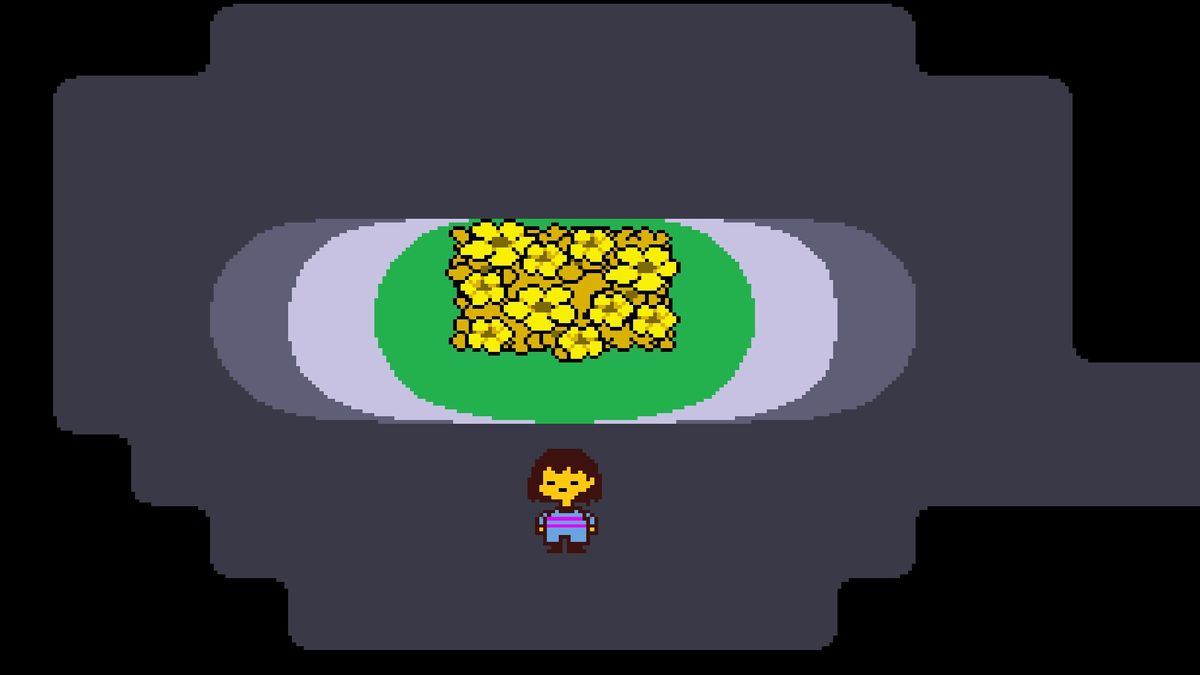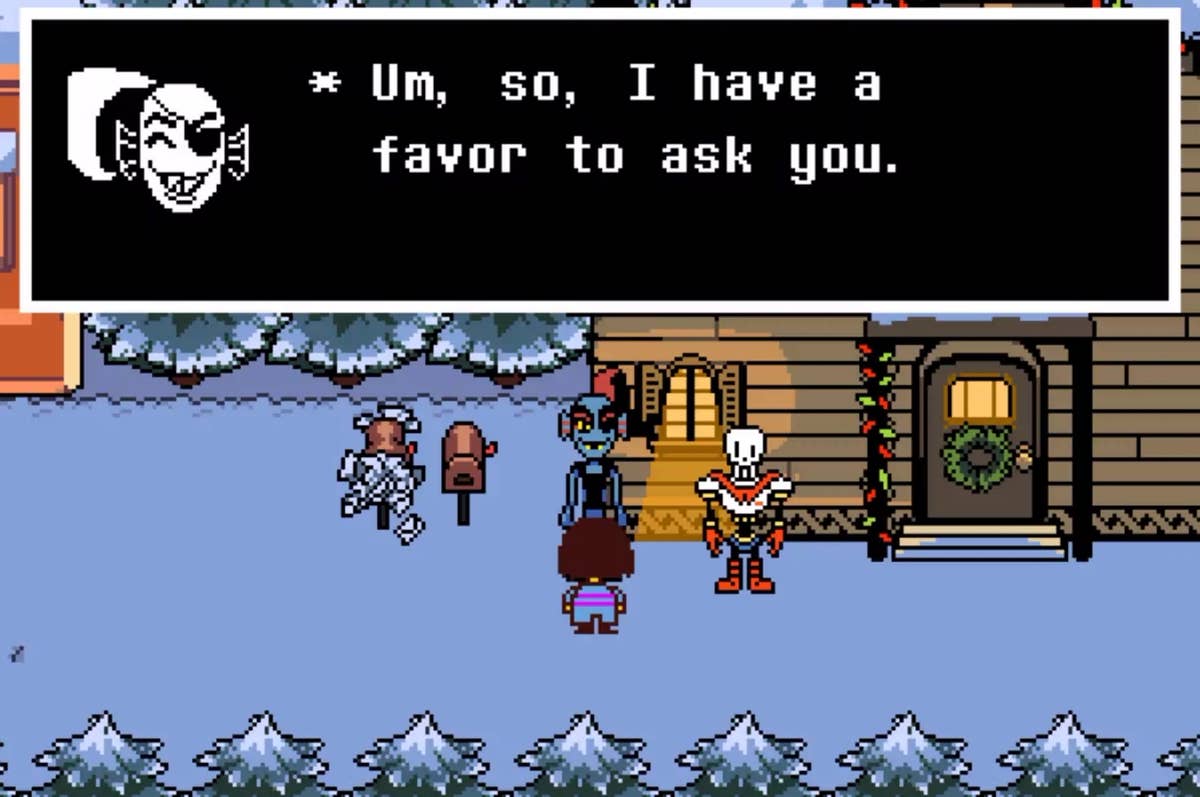
I finished my first playthrough of Undertale in stunned silence. My journey began with corny puns and silly riddles, but the ending moved me in a way I never expected. That’s kind of Undertale’s specialty: it reflects our expectations of what an RPG should be, subverts them, and uses them to tell unique stories of what games can do. His powerful writing style, integration of gameplay and storytelling, and deep understanding of his audience create something to surprise at every turn.
As a lone human dropped into an underworld that serves as a prison for monsters, my journey was preordained, as is the protagonist in most role-playing games. On my first playthrough, I took a pacifist approach, being as kind and merciful as I could while searching for a way back to the surface. But I made a mistake: I accidentally killed a monster the first time around. So, like you would if you were to start over in any game, I restarted without saving. Except… this time everything was different. The dialogue had changed to reflect that I had watched her die. Then Flowey, Undertale’s chaotic evil, fourth-wall-breaking flower, attacked me because I had the audacity to abuse the power of the nation I’d saved.
Gaming the System

Undertale expected me to have played role-playing games before, and played with those conventions in unexpected ways. That initial scolding from Flowey shaped my experience thereafter. I learned that I had to tread carefully, that I couldn’t rely on a soft reset. Everything I did mattered. This clever manipulation of game mechanics adds weight to a story that couldn’t be told in any other way or in any other medium. Undertale needs to be a game, and that’s key to how great it is. The dodge-based combat minigames especially play off of this concept. Even after I thought I had it all figured out, boss fights always subverted my expectations, but even the regular random encounters are deeply intertwined with the storytelling and worldbuilding. Each enemy has its own personality, expressed through both combat and non-combat options. In my pacifist playthrough, I ended up talking to, hugging, and (especially) flirting with a lot of monsters just to avoid having to kill them. To avoid monsters who wanted to flirt but wouldn’t admit it, I had to “get too close, but not too close.” This option changed the rules of combat, forcing me to narrowly dodge flying projectiles until the monsters turned red and stopped fighting.
There are plenty of jokes that appeal to internet nerds, and I often felt like Undertale was speaking to me directly, as if it knew what I was thinking. For example, the anime-loving character’s “selfie” was actually a photo of a trash can with a pink glitter filter over it (I can tell you from experience that this is very accurate). I love Undertale’s humor, especially when it has something to say, no matter how subtle it may be. I was in a snail race (called Thundersnail) and was told to press Z repeatedly to make the snail win. I spammed Z until it burst into flames, and the Thundersnail organizer told me that “the pressure to succeed was getting to her a lot.” Like many of Undertale’s one-off jokes, this one was very relatable. And knowing and predicting its audience is one of Undertale’s greatest strengths.
Monsters Are People Too

Undertale’s writing style is consistently funny, but also moving. Small, half-hidden notes and conversations enrich the world, building on an already fascinating tale of humanity and morality. A favorite was a series of “echo flowers” in a beautiful, fantastical hallway, repeating snippets of overheard conversation. One monster didn’t want to reveal his greatest wish — to one day climb the mountain that holds all the monsters underground and view the world — for fear of being laughed at, and despite his girlfriend promising him he wouldn’t, and that he would, his friend laughed at the end. It was silly until the last flower repeated, “Sorry, just funny… that’s my wish too.”
Experiencing the depth of the monsters’ hopes and dreams is crucial to Undertale’s exploration of morality, personality, and conflict. The various monsters talk about each other right in front of me, so when I actually met them, I got to know them for who they are, as opposed to their reputation. Most of the main characters are very well developed and have consistent personalities across different conversations and storylines. I struggled to muster the aggression to attack one of them – and that was exactly the point. When I tried to play a more violent version, fighting the monsters I once flirted with drove Undertale’s message about humanity home even more.
Determination

However, some combats can be frustrating or boring, at least at first. In one violent playthrough, I had to put in a lot of effort to complete certain story requirements, which became too much for me after a while. But in the more peaceful deployments, fighting one enemy after another replaced puzzles, and the trade-off felt very balanced and ultimately meaningful to the story. I also found myself trudging back through areas I’d already cleared just to beat a boss or get an item. It was ultimately worth it, but not particularly exciting. At one point I ran out of gold and needed to buy healing items, and the only store that would buy them was about a 10-minute walk away. (Other shopkeepers won’t buy items because they don’t want your trash.)
Still, I don’t regret spending the extra time walking around, because I managed to find things like Thundersnails and Echo Flowers. It’s the little details that make Undertale special, and I wanted to see them all. Each of these feels intentional. The long conversations at the beginning and certain battles can be time-consuming, but they’re necessary to establish character in a way that only games can. In another playthrough, even disappointing boss fights become sad because a one-hit KO means the world. Undertale’s ongoing, well-woven theme of determination is what kept me coming back for more.
The art isn’t always beautiful – sometimes it’s ugly – but Undertale is an incredibly expressive game from start to finish, compensating for its visual limitations with excellent music and compelling animation. It’s also inclusive in terms of gender and sexuality in a very realistic and tangible way. Every detail reveals a deep understanding of its audience, and that’s essential to making Undertale’s character commentary so effective.
Playstation 4 Review, August 15 2017
After playing Undertale on the PS4, I am happy to report that everything has been ported perfectly to the console (including save game wise interpretations and the like). The only real additions I noticed are on the edges such as the ability to set a central 4:3 screen background, and the dynamically changing graphics are a nice touch. You can also choose to use either the analog stick or the D-pad for both world movement and combat. Both work well, but I prefer the buttons over the stick due to the increased sensitivity of the stick for certain combats.
Verdict
It’s hard to express how much I love Undertale without saying anything major, but here’s why I love it. This story is told in such a dynamic way that fully understands the mindset of an RPG gamer that it couldn’t be told any other way – it’s a beautifully crafted experience that won’t soon be forgotten.

Leave a Reply